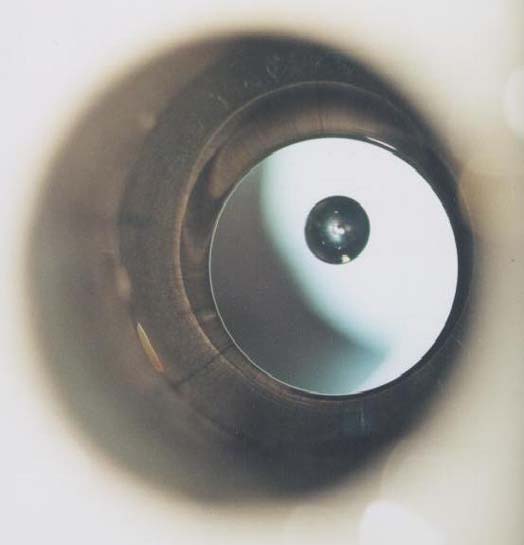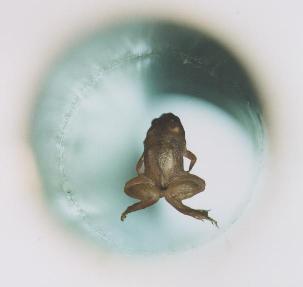
Perfectly spherical water droplet in a high gradient magnetic field.
Magnetic levitation
Every element (in the periodic system) is magnetic. However, there are three main levels or domains of magnetism. The smallest effect is know as diamagnetism and is a property of elements like antimony, bismuth, copper, carbon but also phosphorus and hydrogen. Paramagnetism has an intermediate value, about two orders of magnitude higher than diamagnetism. Paramagnetism is seen in e.g. aluminum, zinc, liquid oxygen but also in glass and rubber. The largest magnetic effect is known as ferromagnetism. This is, in our daily life, the most common form of magnetism. The only elements with ferromagnetic properties are iron, cobalt, and nickel. Ferromagnetism is about 109 times larger compared to diamagnetism.
Ferro and paramagnetic elements may easily be levitated in low gradient magnetic
fields. This system is used in various commercial products. To elevate diamagnetic
materials, however, much higher field strengths and field gradients are necessary.
In such a high power magnet organic materials or even living biological samples
may be elevated, thereby counteracting the force of gravity.
Although the various systems have their specific limitations, for some small
samples this microweight 'simulation' may be used to study living samples in
preparation of a real microweight experiment.

Perfectly spherical water droplet in a high gradient magnetic field.

Life toad levitated in high gradient magnetic field.
Levitation Magnet Detailed Description
|
All facilities mentioned are open to perform your individual, dedicated, experiments or for collaborative studies. When you are interested to perform a series of (pilot) studies using the levitation magnet you are invited to contact us and discuss various possibilities. You may also directly send an experiment proposal either to DESC or respond to one of the international 'Announcements of Opportunities' (AO) as are in general annually issued by the European Space Agency (ESA) or other space agencies. You may also apply via an unsolicited proposal to ESA via the 'fast track' Continuously Open Research Announcements. You may contact us when you need any support for this. Dutch scientists may also apply nationally via a NSO-NWO proposal. An additional copy of the proposal has to be provided to DESC for technical and operational evaluations.
The magnet for levitation experiments is located and operated at the High Field Magnet Laboratory of the University of Nijmegen in the Netherlands. Please visit their site to obtain additional information on the physics underlying this phenomenon and look at some in situ video sequences on biological samples and fluids or to download various papers.